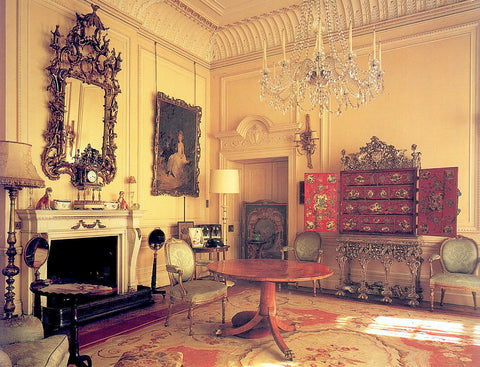Inside Clarence House
Share

Edward Halliday (1902-1984) Maundy Thursday, 1952
We were lucky enough to join a small tour of Clarence House, last week. The house is open to the public during the month of August. If you happen to be in London, I would urge you to go- there are only a few days left. Many, of course, will remember Clarence House as the official London residence of the late Queen Elizabeth, The Queen Mother. It's now the London house of TRH The Prince of Wales and the Duchess of Cornwall.
Clarence House was built between 1825 and 1827, for William, Duke of Clarence and his wife, Adelaide. Clarence was later crowned King William IV. The architect was John Nash. Nash, of course, is also known for the Brighton Pavilion, Regent's Park, the Garden Front of Buckingham Palace and Carlton House Terrace. If the exterior is all wedding-cake and stucco, the interior resembles a relaxed English Country House (albeit with antiques and paintings of the very highest quality; the Queen Mother had an excellent eye for Modern British painting), and has recently been renovated by Robert Kime in a successful and most sympathetic fashion. (Talking of Robert Kime, I've also just reviewed The Gunton Arms on my sister blog. This is a marvellously quirky inn, or pub- with rooms, and comes highly recommended).
It's probably going to be best if we go on our own tour, room by room:

The Entrance Hall

The Lancaster Room
A stunning room, despite its use as an unofficial 'waiting room'. Paintings include portraits of King Edward VIII, a series of watercolours by John Piper (more about those later) and a terrific Winterhalter (The Presentation of King Louis-Phillipe's Grandsons to Queen Victoria at the Château d'Eu). The chimneypiece originally came from a house in Dublin. The bronze on the table is a charming study of Winston Churchill and his wife, Clemmie, by Oscar Nemon.

The Morning Room

The Morning Room as re-arranged by Robert Kime (photograph taken from The World of Interiors)

The Morning Room (as rearranged by Robert Kime)
The Morning Room is currently on my 'top ten most beautiful rooms' list. Many of the Modern British paintings were collected by The Queen Mother. The painting of King George V in his racing bowler is by Walter Sickert (recently accused, in that silly book, of being Jack the Ripper), the bearded chap on the right (actually with his eyes closed) is George Bernard Shaw, as painted by Augustus John. The painting above the chimneypiece is A Lady in a Pink Ballgown, again by Sickert. To the left (and out of camera) hangs a charming Jamaican study, by none other than our old friend, Noel Coward. The alcoves contain the Queen Mother's collection of eighteenth century Cheslea porcelain. To modern eyes, this room seems timeless, but compare it with the photograph below:

Believe it or not, this is the very same room- but as it appeared at the end of the nineteenth century. The aesthetic taste on display is a very different beast from the current arrangement, which is very twentieth century- and mid-twentieth century, at that.

The Library
Another charming room. The Queen Mother knocked the Morning Room through, so that it opens up onto this room. Robert Kime reinstated the fabulous bookcases on either side of the door. The bookcase on the right holds the Queen Mother's favourite books, which included P. G. Wodehouse, Dick Francis, Alain-Fournier's Le Grande Meaulnes, and Siegfried Sassoon. At Christmas, the Duchess of Cornwall holds a party for disabled children in this room; a tall sergeant major from the Brigade of Guards helps them to decorate the tree.

HRH The Duchess of York (Elizabeth Bowes-Lyon) by Savey Sorine (1887-1953)
This portrait of the Queen Mother was painted in 1936, the same year as the Abdication Crisis. It hangs in the Library.

The Dining Room (photograph from The World of Interiors)
The portrait of the Queen Mother was painted by Augustus John. He was never happy with it, and it remains unfinished. The smaller painting to the left is a stunning watercolour by John Piper. During the Second World War, Kenneth Clark recommended that Windsor Castle should be painted- in a series of studies- by John Piper. There was a very real fear that, in the event of a German invasion, the castle could be destroyed. Piper's work is superb, and the castle is depicted against menacing and brooding English skies:


The Garden Room
It's a great photograph, but funnily enough, I found that this room was the least successful. The red japanned secretaire bureau is German, and belonged to Queen Mary, a terrific collector of antiques. The musical score on the piano (out of camera) is signed by Noel Coward.

The Smaller Drawing Room (as decorated by The Queen Mother)

The Duchess of Kent's Drawing Room

The Duchess of Kent's Sitting Room
Fitted carpets were all the rage.

The Russian Orthodox Chapel
Designed by C. B. Waller, this private chapel was installed on the first floor for the Russian born Duchess of Edinburgh. The Chapel was demolished in 1900.
2 comments
Peak of Chic-
I loved Clarence House, charming atmosphere, and genuinely understated elegance- I hadn’t appreciated what a good Eye the Queen Mother had: Royal Lodge is also fascinating- but not open to the public. There’s a book about it I want to track down.
I prefer Robert Kime’s Morning Room, to the Queen Mother’s version (top photo). It’s all very subtle. I think he’s softened the wall colour (more grey), introduced some non-matching upholstery and slightly re-arranged it. Very subtle changes. Less is More. Reminds me of David Mlinaric’s approach.
What I like almost as much as the Morning Room is that glorious Edward Halliday painting.
The interiors are certainly very warm and comfortable, not to mention charming, too. Robert Kime is quite the master at decorating, isn’t he!